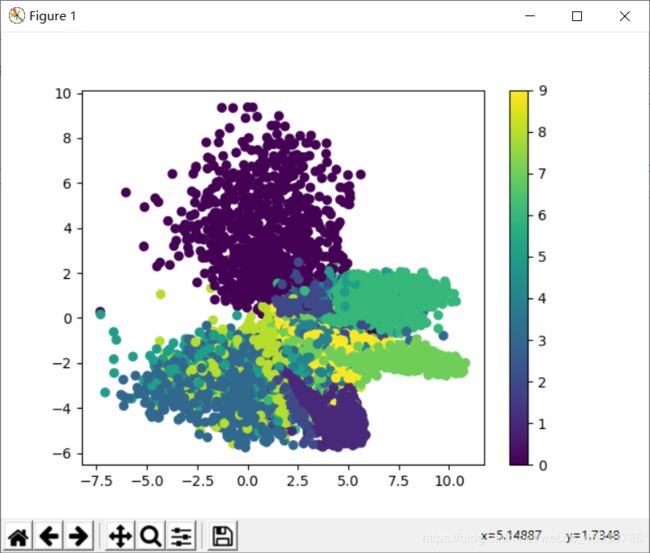Keras【Deep Learning With Python】Autoencoder 自编码(看不懂你打我系列!)
文章目录
- 1 前言
- 2 Autoencoder
- 2.1 编码器 Encoder (—PCA主成分分析一个道理)
- 2.2 解码器 Decoder
- 3 代码实现
- 4 讲解
- 6 输出结果
1 前言
本文分为讲解自编码,和针对Mnist数据集的代码实现两部分。
2 Autoencoder
自编码,简单来说就是把输入数据进行一个压缩和解压缩的过程。 原来有很多 Feature,压缩成几个来代表原来的数据,解压之后恢复成原来的维度,再和原数据进行比较。
它是一种非监督算法(不用标签),只需要输入数据,解压缩之后的结果与原数据本身进行比较。
今天要做的事情是把 datasets.mnist 数据的 28×28=784 维的数据,压缩成 2 维的数据,然后在一个二维空间中可视化出分类的效果。

原来有时神经网络要接受大量的输入信息, 比如输入信息是高清图片时, 输入信息量可能达到上千万, 让神经网络直接从上千万个信息源中学习是一件很吃力的工作. 所以, 何不压缩一下, 提取出原图片中的最具代表性的信息, 缩减输入信息量, 再把缩减过后的信息放进神经网络学习. 这样学习起来就简单轻松了. 所以, 自编码就能在这时发挥作用. 通过将原数据白色的X 压缩, 解压 成黑色的X, 然后通过对比黑白 X ,求出预测误差, 进行反向传递, 逐步提升自编码的准确性. 训练好的自编码中间这一部分就是能总结原数据的精髓. 可以看出, 从头到尾, 我们只用到了输入数据 X, 并没有用到 X 对应的数据标签, 所以也可以说自编码是一种非监督学习. 到了真正使用自编码的时候. 通常只会用到自编码前半部分.
2.1 编码器 Encoder (—PCA主成分分析一个道理)
这 部分也叫作 encoder 编码器. 编码器能得到原数据的精髓, 然后我们只需要再创建一个小的神经网络学习这个精髓的数据,不仅减少了神经网络的负担, 而且同样能达到很好的效果.

这是一个通过自编码整理出来的数据, 他能从原数据中总结出每种类型数据的特征, 如果把这些特征类型都放在一张二维的图片上, 每种类型都已经被很好的用原数据的精髓区分开来. 如果你了解 PCA 主成分分析, 再提取主要特征时, 自编码和它一样,甚至超越了 PCA. 换句话说, 自编码 可以像 PCA 一样 给特征属性降维.
2.2 解码器 Decoder
至于解码器 Decoder, 我们也能那它来做点事情. 我们知道, 解码器在训练的时候是要将精髓信息解压成原始信息, 那么这就提供了一个解压器的作用, 甚至我们可以认为是一个生成器 (类似于GAN). 那做这件事的一种特殊自编码叫做 variational autoencoders, 你能在这里找到他的具体说明.
3 代码实现
import numpy as np
np.random.seed(1337) # for reproducibility
from keras.datasets import mnist
from keras.models import Model
from keras.layers import Dense, Input
import matplotlib.pyplot as plt
# download the mnist to the path '~/.keras/datasets/' if it is the first time to be called
# X shape (60,000 28x28), y shape (10,000, )
(x_train, _), (x_test, y_test) = mnist.load_data()
# data pre-processing
x_train = x_train.astype('float32') / 255. - 0.5 # minmax_normalized
x_test = x_test.astype('float32') / 255. - 0.5 # minmax_normalized
x_train = x_train.reshape((x_train.shape[0], -1))
x_test = x_test.reshape((x_test.shape[0], -1))
print(x_train.shape)
print(x_test.shape)
"""
(60000, 784)
(10000, 784)
"""
# in order to plot in a 2D figure
encoding_dim = 2
# this is our input placeholder
input_img = Input(shape=(784,))
# 把 datasets.mnist 数据的 28×28=784 维的数据,压缩成 2 维的数据,然后在一个二维空间中可视化出分类的效果。
# encoder layers
encoded = Dense(128, activation='relu')(input_img)
encoded = Dense(64, activation='relu')(encoded)
encoded = Dense(10, activation='relu')(encoded)
encoder_output = Dense(encoding_dim)(encoded)
# decoder layers
decoded = Dense(10, activation='relu')(encoder_output)
decoded = Dense(64, activation='relu')(decoded)
decoded = Dense(128, activation='relu')(decoded)
decoded = Dense(784, activation='tanh')(decoded)
# construct the autoencoder model
autoencoder = Model(input=input_img, output=decoded)
# construct the encoder model for plotting
encoder = Model(input=input_img, output=encoder_output)
# compile autoencoder
autoencoder.compile(optimizer='adam', loss='mse')
# training
autoencoder.fit(x_train, x_train,
nb_epoch=20,
batch_size=256,
shuffle=True)
# plotting
encoded_imgs = encoder.predict(x_test)
plt.scatter(encoded_imgs[:, 0], encoded_imgs[:, 1], c=y_test)
plt.colorbar()
plt.show()
4 讲解
导入模块并创建数据
数据仍然用 datasets.mnist。
import numpy as np
np.random.seed(1337) # for reproducibility
from keras.datasets import mnist
from keras.models import Model
from keras.layers import Dense, Input
import matplotlib.pyplot as plt
#download the mnist to the path ‘~/.keras/datasets/’ if it is the first time to be called
#X shape (60,000 28x28), y shape (10,000, )
(x_train, _), (x_test, y_test) = mnist.load_data()
#data pre-processing
x_train = x_train.astype(‘float32’) / 255. - 0.5 # minmax_normalized
x_test = x_test.astype(‘float32’) / 255. - 0.5 # minmax_normalized
x_train = x_train.reshape((x_train.shape[0], -1))
x_test = x_test.reshape((x_test.shape[0], -1))
print(x_train.shape)
print(x_test.shape)
“”"
(60000, 784)
(10000, 784)
“”"
建立模型
encoding_dim,要压缩成的维度。
#in order to plot in a 2D figure
encoding_dim = 2
#this is our input placeholder
input_img = Input(shape=(784,))
接下来是建立 encoded 和 decoded ,再用 autoencoder 把二者组建在一起。训练时用 autoencoder。
encoded 用4层 Dense 全联接层,激活函数用 relu,输入的维度就是前一步定义的 input_img。
接下来定义下一层,它的输出维度是64,输入是上一层的输出结果。
在最后一层,我们定义它的输出维度就是想要的 encoding_dim=2。
解压的环节,它的过程和压缩的过程是正好相反的。相对应层的激活函数也是一样的,不过在解压的最后一层用到的激活函数是 tanh。 因为输入值是由 -0.5 到 0.5 这个范围,在最后一层用这个激活函数的时候,它的输出是 -1 到 1,可以是作为一个很好的对应。
#encoder layers
encoded = Dense(128, activation=‘relu’)(input_img)
encoded = Dense(64, activation=‘relu’)(encoded)
encoded = Dense(10, activation=‘relu’)(encoded)
encoder_output = Dense(encoding_dim)(encoded)
#decoder layers
decoded = Dense(10, activation=‘relu’)(encoder_output)
decoded = Dense(64, activation=‘relu’)(decoded)
decoded = Dense(128, activation=‘relu’)(decoded)
decoded = Dense(784, activation=‘tanh’)(decoded)
#construct the autoencoder model
autoencoder = Model(input=input_img, output=decoded)
接下来直接用 Model 这个模块来组建模型,输入就是图片,输出是解压的最后的结果。
#construct the encoder model for plotting
encoder = Model(input=input_img, output=encoder_output)
当我们想要看由 784 压缩到 2维后,这个结果是什么样的时候,也可以只单独组建压缩的板块,此时它的输入是图片,输出是压缩环节的最后结果。
激活模型
接下来是编译自编码这个模型,优化器用的是 adam,损失函数用的是 mse。
#compile autoencoder
autoencoder.compile(optimizer=‘adam’, loss=‘mse’)
训练模型
接下来训练自编码模型,注意它的输入和输出是一样的,都是训练集的 X。
#training
autoencoder.fit(x_train, x_train,
nb_epoch=20,
batch_size=256,
shuffle=True)
“”"
Epoch 20/20
60000/60000 [==============================] - 7s - loss: 0.0398
“”"
可视化结果
最后看到可视化的结果,自编码模型可以把这几个数字给区分开来,我们可以用自编码这个过程来作为一个特征压缩的方法,和PCA的功能一样,效果要比它好一些,因为它是非线性的结构。
#plotting
encoded_imgs = encoder.predict(x_test)
plt.scatter(encoded_imgs[:, 0], encoded_imgs[:, 1], c=y_test)
plt.colorbar()
plt.show()



